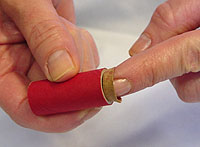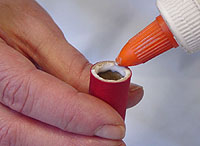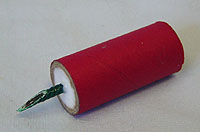AERIAL MORTARS
| An Aerial Mortar is basically a tiny tube that shoots a small tube projectile, called a "shell," high into the sky. The shell can contain a whistle, star, smoke bomb, or other firework effect. The shell is timed to ignite when it reaches its highest point (known as the "apogee") in the sky. The aerial mortar is composed of two main parts; the mortar (launch tube), and the projectile (shell). |
THE SHELL PROJECTILE
| Take a 1-1/2" piece of Visco Fuse, and using a razor blade or Fuse Cutters, cut one end in a sharp diagonal. This is done in order to expose a larger amount of the black powder core inside the fuse and ensure that it will ignite during launch. Do not cut the fuse with scissors or similar tool. Not only are scissors an ignition hazard, but they also do not make a clean cut; they can actually simultaneously crush the powder core and close the fuse end, making ignition much less reliable. There is no need to cut a diagonal on the other end of the fuse. |
| This end plug is going to be the bottom of the shell (projectile), and to make it strong enough to withstand the blast of launching it out of the mortar, we're going to use it backwards in the tube and reinforce it. Be sure to punch a hole in it for the fuse. Press the end plug in one end of the tube, and using a small stick or pencil, push the plug all the way to the other end, leaving a full 1/2" of space above it. This space is important; it will serve as the time delay. |
| Insert the 1-1/2" piece of fuse (with the diagonal end sticking out) so about 1/2" is outside the shell. |
| Stand the tube up, and fill the empty space with Elmer's White Glue. This will have to dry for several hours if not overnight before you can continue. It is possible to use hot glue in place of Elmer's at this point if you're impatient; you need only to wait until the glue cools, which should be in about 15 minutes. It should be noted, however, that we have had a few misfires using hot glue, and Elmer's is really the better choice. It's possible that under the right conditions the molten glue surrounding the fuse effects the powder core in some way. In any case, if you're just too impatient to use Elmer's, and do use hot glue, be sure to use a low-temperature gun and low-temperature glue sticks. This 1/2" thick gap that you filled with glue will serve as the time delay for the shell. Safety Fuse burns at about 3 seconds per inch, so it takes the fuse about 1.5 seconds to burn through the 1/2" thick glue plug you just made. This gives the shell time to reach its maximum altitude before the fuse burns all the way through into the powder. You can adjust this delay by making the glue-filled gap thicker or thinner. If the projectile ignites before reaching its maximum height, make the plug thicker. If it ignites after it reaches its maximum height and is on the way back down, make the plug a bit thinner. |
| Fill with your favorite pyrotechnic composition Smear some Elmer's glue around the lip of the tube and press in the other end plug. Push the plug into the tube so there's about a 1/16" gap between the tube end and the plug edge. This is just so we've got another anchor point for more glue between the tube and plug. Smear a good quantity of glue around the rim so the end plug will be locked into place. This end of the tube MUST be glued with Elmer's, not with hot glue. Since the glue layer is not very thick, it will not take that long to dry. |
| Set the completed shell aside to dry. |
THE MORTAR
| The mortars for the aerial mortar come in 2 pieces; a small plastic base, and a heavy-wall launch tube. We offer 3 sizes: |
| Using an 1/8" drill, make a hole 3/4" from the bottom of the tube. This will be the fuse hole. |
| Spread some Elmer's or hot glue around the indent in the base and firmly press the tube into the base. Make sure that the tube is pointing up straight from the base. |
| Cut a 3" piece of Visco Fuse and insert it all the way into the hole. Spread a little Elmer's around the hole to hold the fuse in place if it is loose. |
| Pour in a 1/8 TEASPOON of granulated black powder into the mortar. |
| Push your shell (fuse first) all the way down into the mortar. The shell should slide easily down into the tube; you should not have to force it. When completely dry, the completed aerial mortar will be ready for use. |
OPERATION
When the fuse is lit, the granulated black powder ignites, shooting the shell up into the air. At the same time, the flame from the lift charge ignites the delay fuse on the shell. When the fuse burns out, the shell ignites in the air. Remember that for every action, there is an equal and opposite reaction. This means that the same amount of force that is shooting the projectile up in the air is pushing back down on the mortar tube. Thus, you should make sure the device is on solid, flat ground. Like everything, the aerial mortar may require some fine tuning. You might have to adjust the amount of black powder (lift powder) or the time-delay plug thickness to get the shell to ignite at the proper time. Don't even think about holding this in your hand and lighting it. It is always possible for the firework to malfunction and explode or flare up.
BE CAREFUL! Under the proper conditions, even fairly "safe" firework compositions can explode violently and cause great injury.














